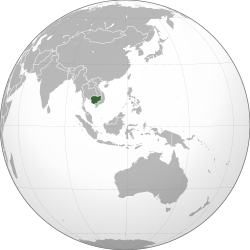
Back كمبوتشيا الديمقراطية Arabic دمکراتیک کمپوچیای AZB Дэмакратычная Кампучыя Byelorussian Демократична Кампучия Bulgarian Kamputxea Democràtica Catalan Demokratická Kampučia Czech Demokratisches Kampuchea German Demokratia Kamboĝo Esperanto Kampuchea Democrática Spanish Kanputxea Demokratikoa Basque
This article needs additional citations for verification. (November 2023) |
| 1975–1982 | |||||||||||||
| Anthem: បទនគររាជ Nôkôr Réach "Majestic Kingdom" (1975–1976) ដប់ប្រាំពីរមេសាមហាជោគជ័យ Dâb Prămpir Mésa Môha Choŭkchoăy "Victorious Seventeenth of April" (1976–1982) | |||||||||||||
 Location of Democratic Kampuchea | |||||||||||||
| Capital and largest city | Phnom Penh | ||||||||||||
| Common languages | Khmer | ||||||||||||
| Religion | State atheism[1] | ||||||||||||
| Government | Unitary one-party socialist republic under a totalitarian dictatorship[2][3][4] | ||||||||||||
| CPK General Secretary | |||||||||||||
• 1975–1979 | Pol Pot | ||||||||||||
| Head of state | |||||||||||||
• 1975–1976 | Norodom Sihanouk | ||||||||||||
• 1976–1979 | Khieu Samphan | ||||||||||||
| Prime Minister | |||||||||||||
• 1975–1976 | Penn Nouth | ||||||||||||
• 1976 | Khieu Samphan | ||||||||||||
• 1976–1979 | Pol Pot | ||||||||||||
| Legislature | People's Representative Assembly | ||||||||||||
| Historical era | Cold War | ||||||||||||
| 17 April 1975 | |||||||||||||
• Constitution established | 5 January 1976 | ||||||||||||
| 21 December 1978 | |||||||||||||
| 7 January 1979 | |||||||||||||
| 22 June 1982 | |||||||||||||
| Currency | None; monetary system abolished | ||||||||||||
| Time zone | UTC+07:00 (ICT) | ||||||||||||
| Date format | dd/mm/yyyy | ||||||||||||
| Drives on | Right | ||||||||||||
| |||||||||||||
| Today part of | Cambodia | ||||||||||||
| History of Cambodia |
|---|
| Early history |
| Post-Angkor period |
| Colonial period |
| Independence and conflict |
| Peace process |
| Modern Cambodia |
| By topic |
|
|
Democratic Kampuchea[a] was the official name of the Cambodian state from 1976 to 1979, under the government of Pol Pot and the Communist Party of Kampuchea (CPK), commonly known as the Khmer Rouge. The Khmer Rouge's capture of the capital Phnom Penh in 1975 effectively ended the United States-backed Khmer Republic of Lon Nol.
From 1975 to 1979, the Khmer Rouge's one-party regime killed millions of its own people through mass executions, forced labour, and starvation, in an event which has come to be known as the Cambodian genocide. The killings ended when the Khmer Rouge were ousted from Phnom Penh by the Vietnamese army. The Khmer Rouge subsequently established a government-in-exile in neighbouring Thailand and retained Kampuchea's seat at the United Nations (UN). In response, Vietnamese-backed communists created a rival government, the People's Republic of Kampuchea, but failed to gain international recognition.
In 1982, the Khmer Rouge established the Coalition Government of Democratic Kampuchea (CGDK) with two non-communist guerrilla factions, broadening the exiled government of Democratic Kampuchea.[5] The exiled government renamed itself the National Government of Cambodia in 1990, in the run-up to the UN-sponsored 1991 Paris Peace Agreements.
- ^ "Cambodia – Religion". Britannica. Retrieved 29 June 2020.
- ^ Jackson, Karl D. (1989). Cambodia, 1975–1978: Rendezvous with Death. Princeton University Press. p. 219. ISBN 0-691-02541-X.
- ^ "Khmer Rouge's Slaughter in Cambodia Is Ruled a Genocide". The New York Times. 15 November 2018. Archived from the original on 13 April 2019. Retrieved 13 April 2019.
- ^ Kiernan, B. (2004) How Pol Pot came to Power. New Haven: Yale University Press, p. xix
- ^ "Cambodia – COALITION GOVERNMENT OF DEMOCRATIC KAMPUCHEA". countrystudies.us. Retrieved 3 October 2020.
Cite error: There are <ref group=lower-alpha> tags or {{efn}} templates on this page, but the references will not show without a {{reflist|group=lower-alpha}} template or {{notelist}} template (see the help page).

